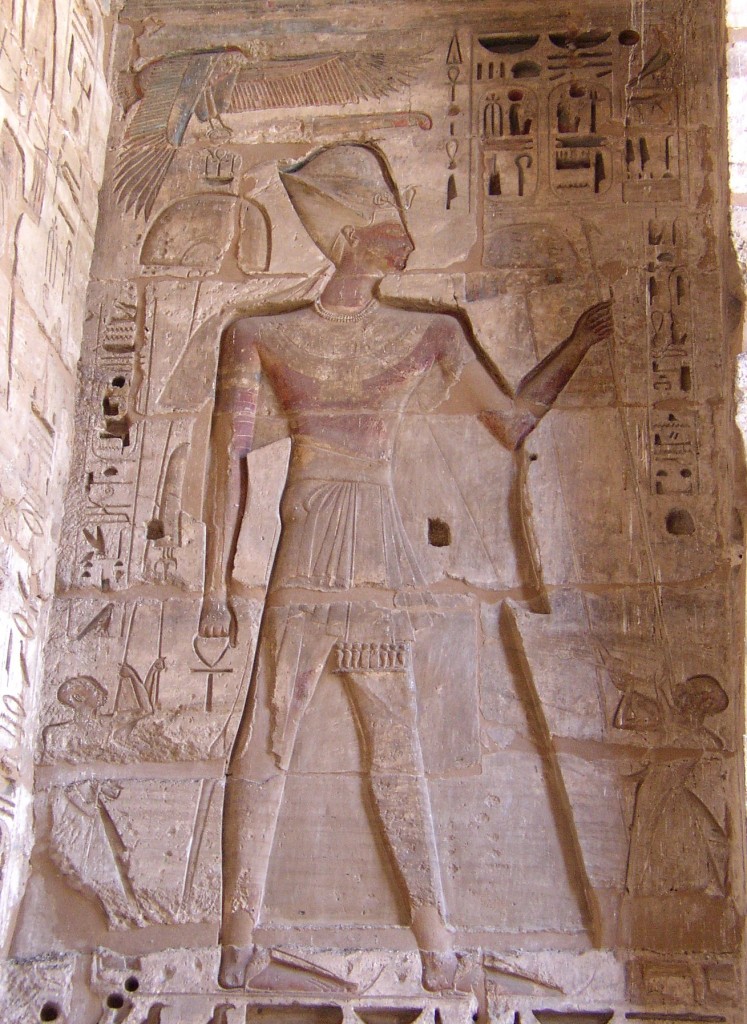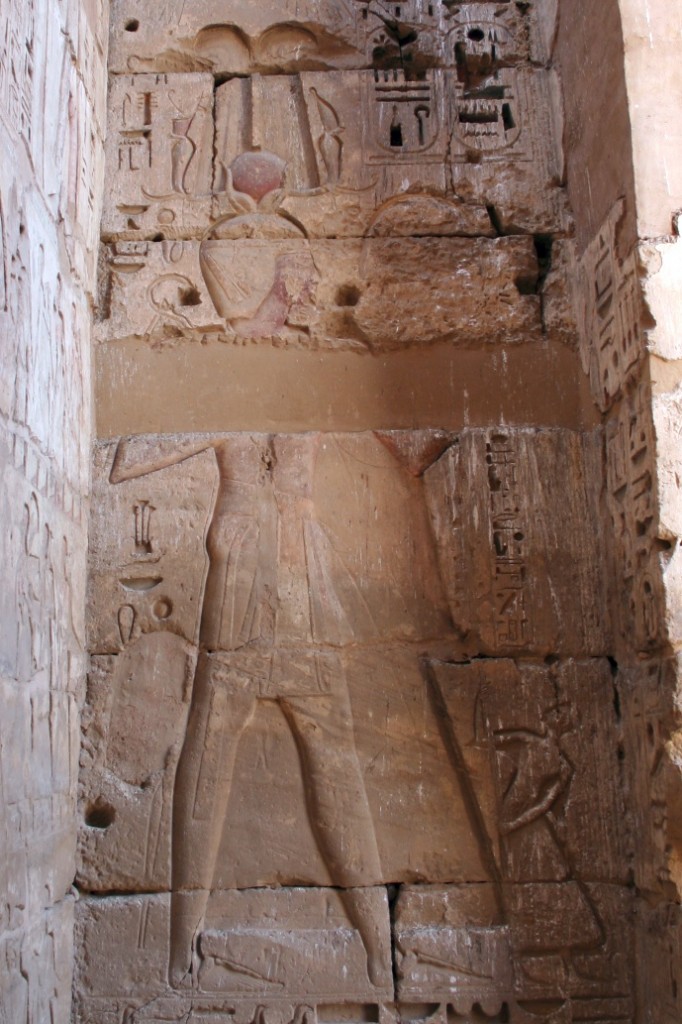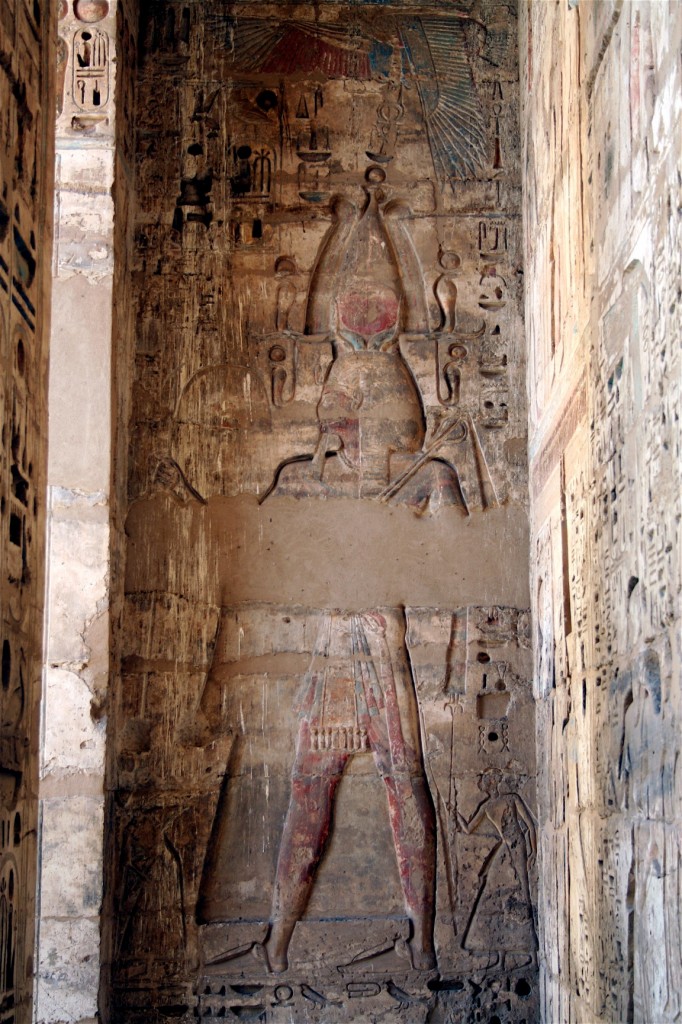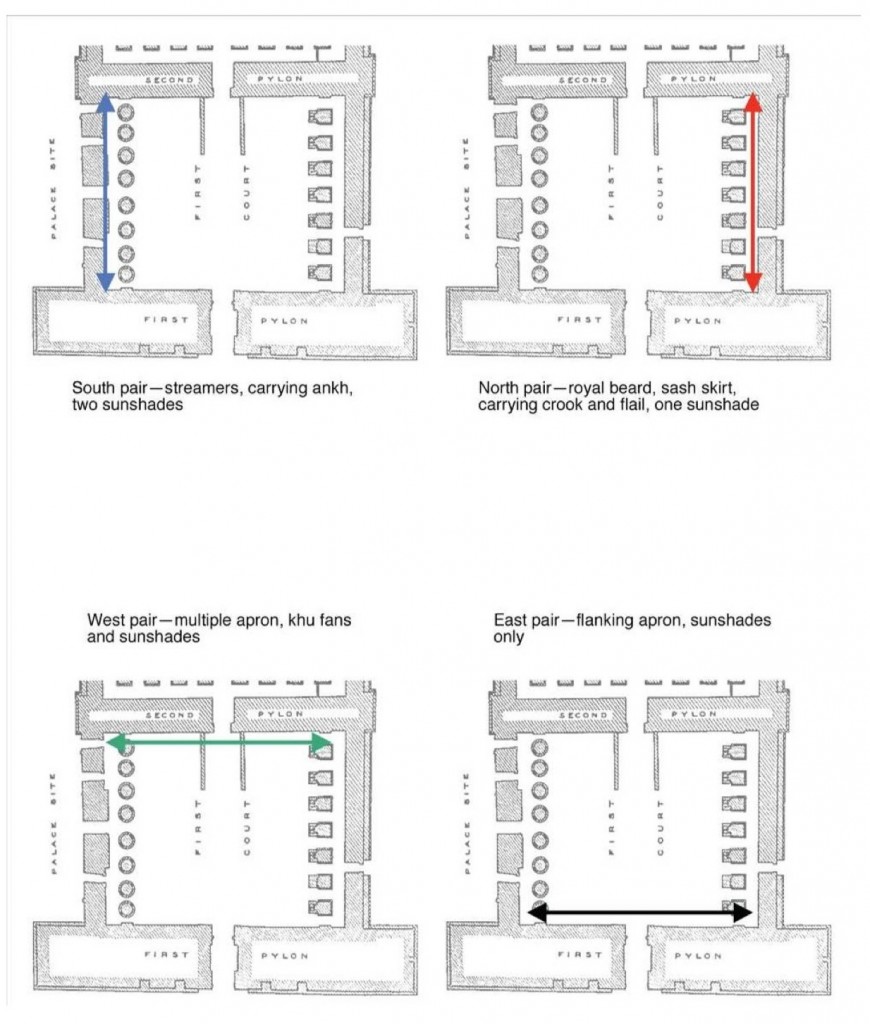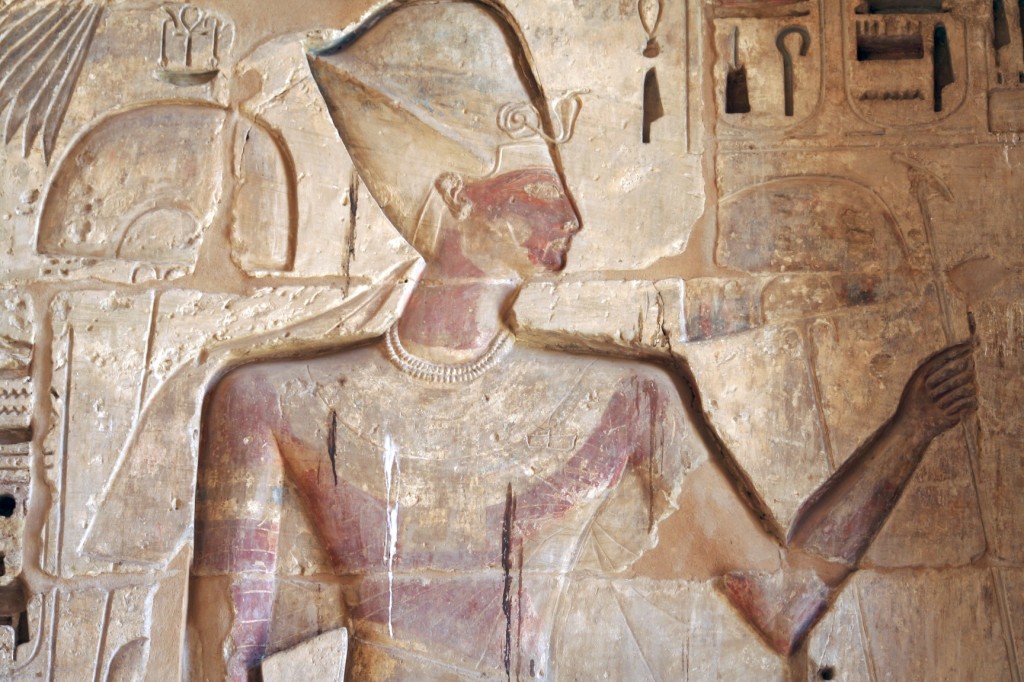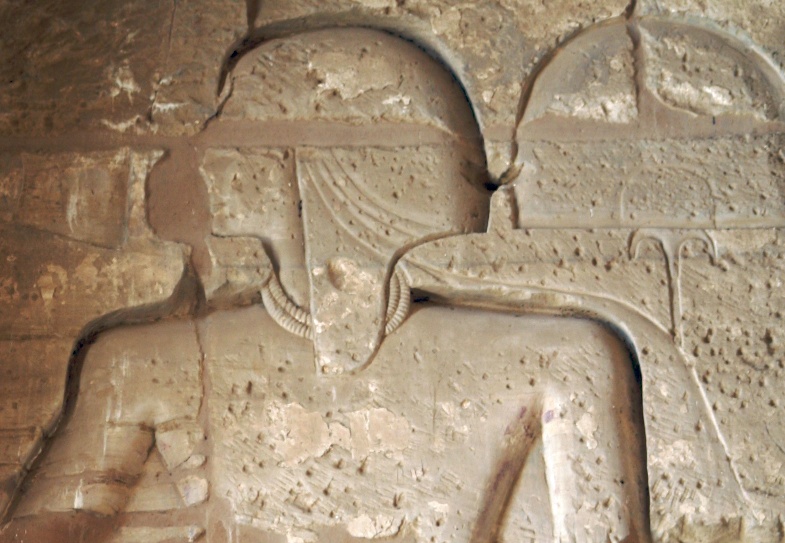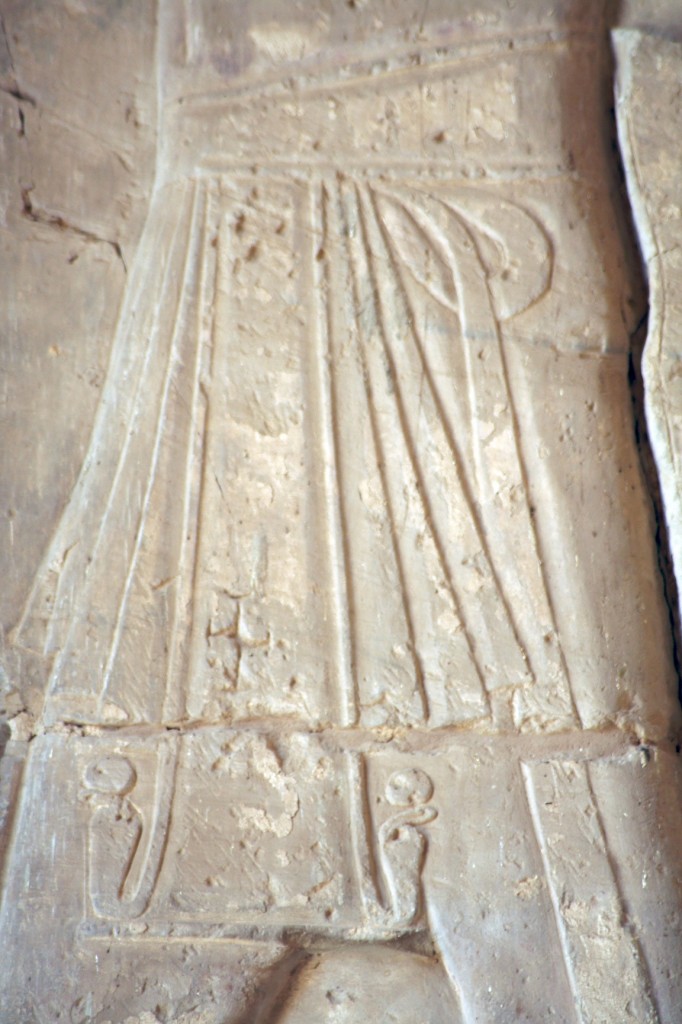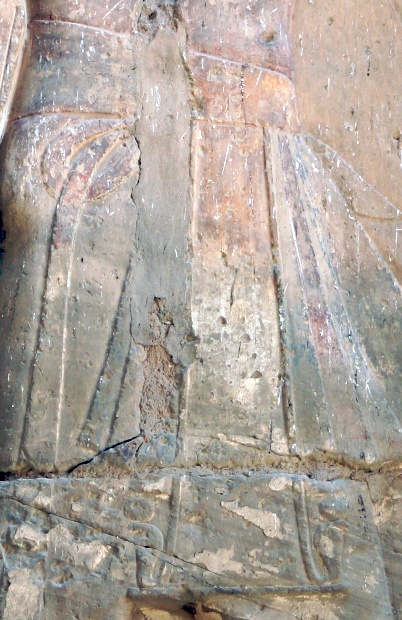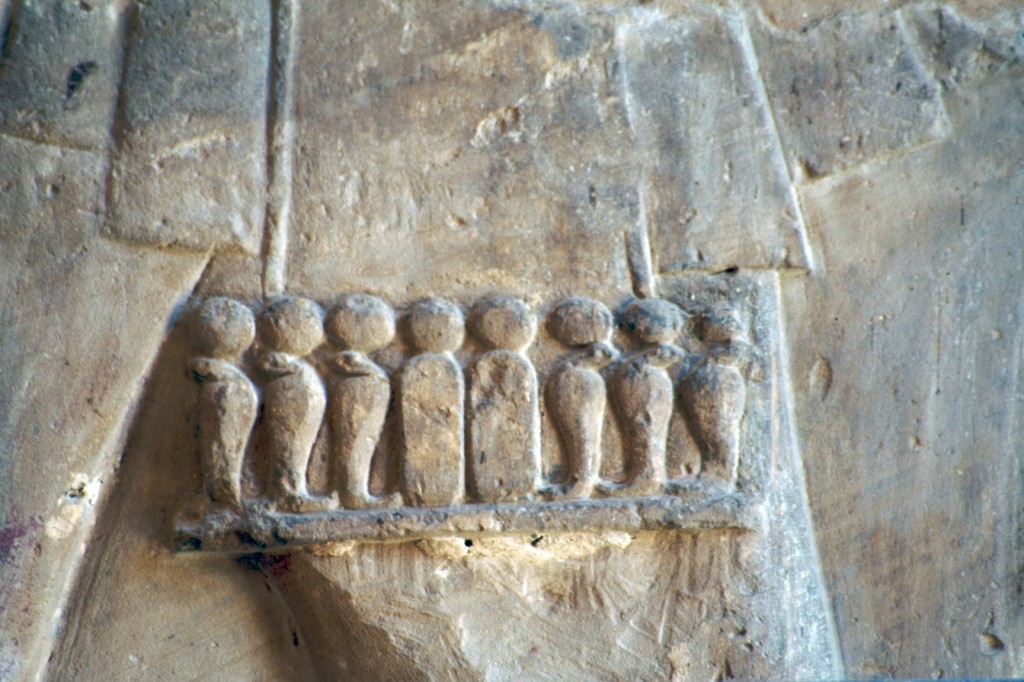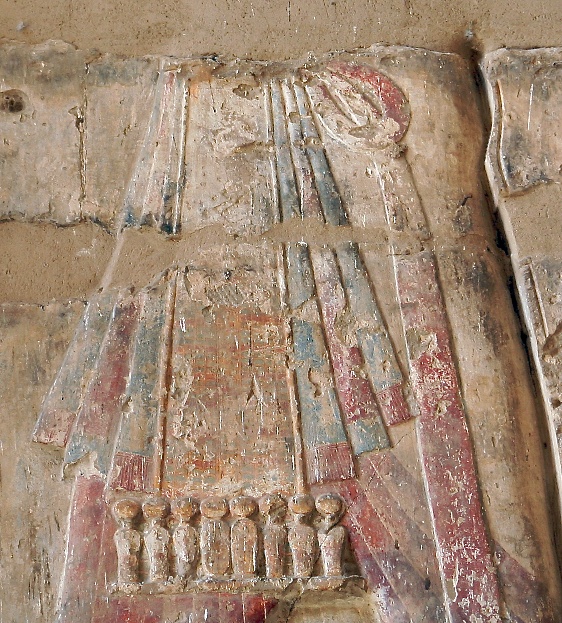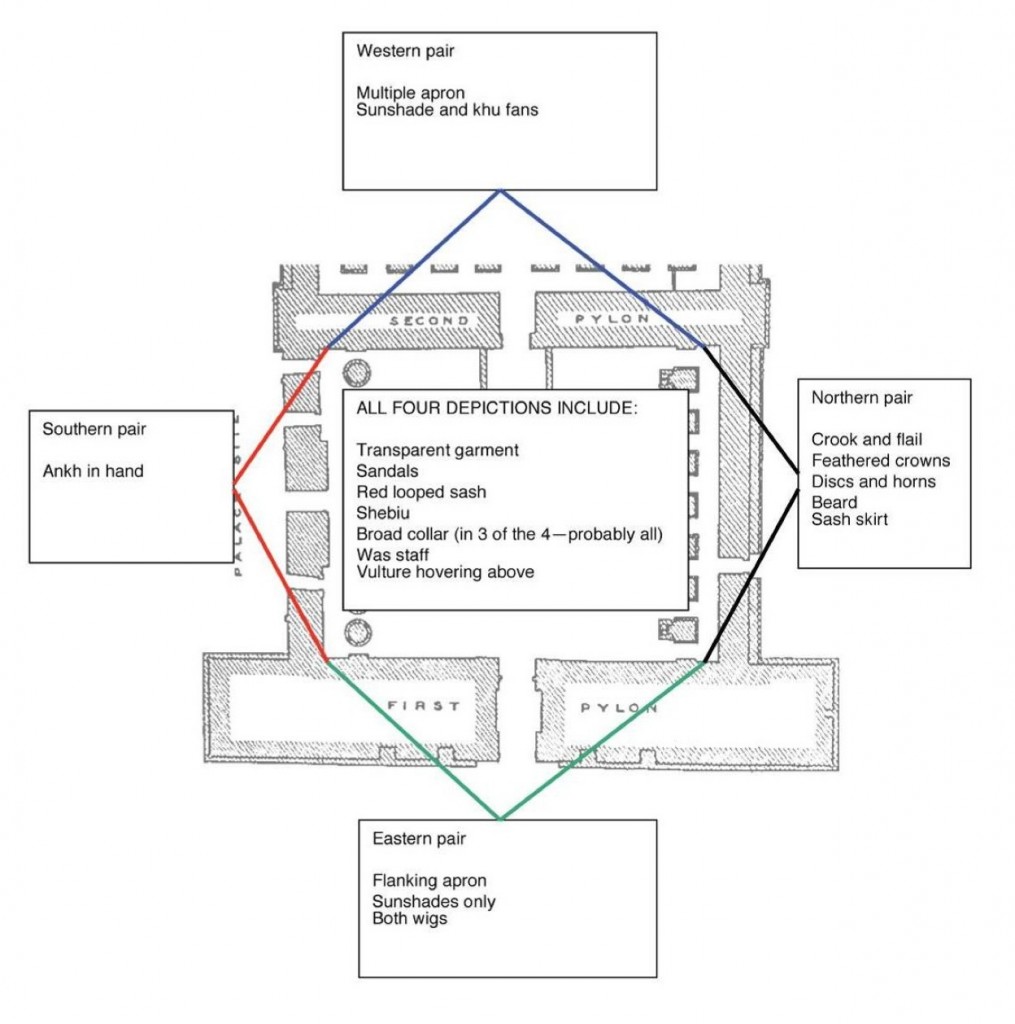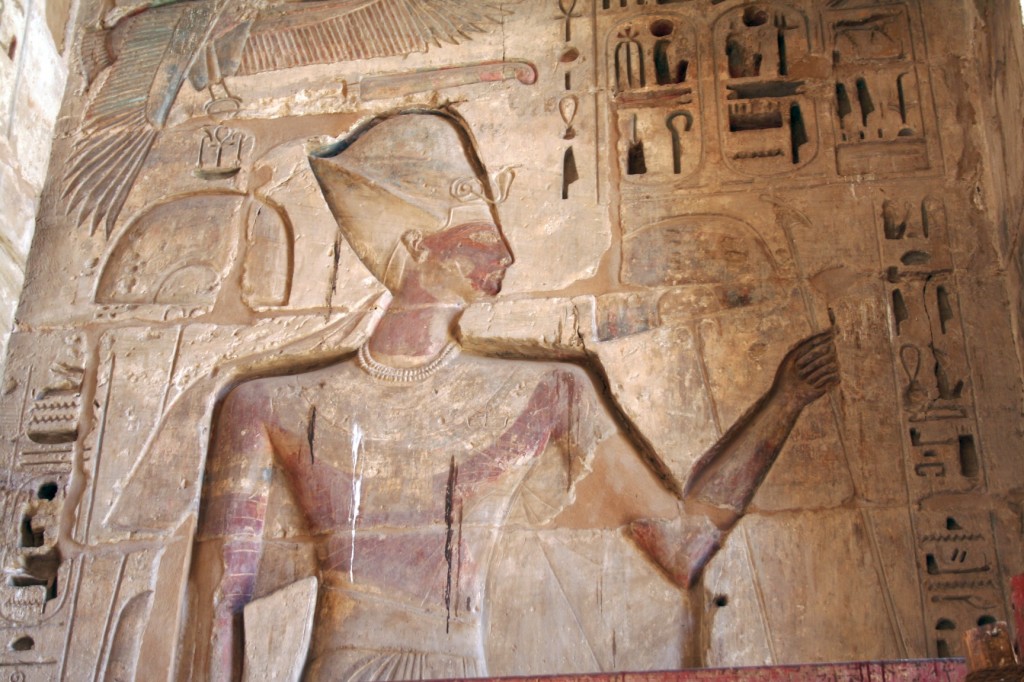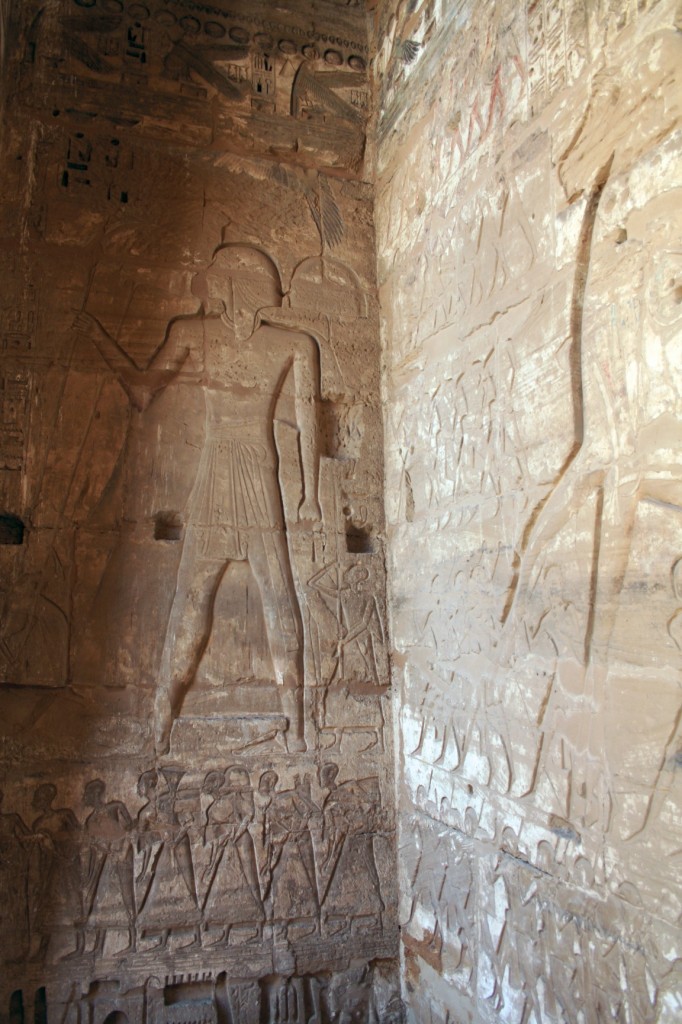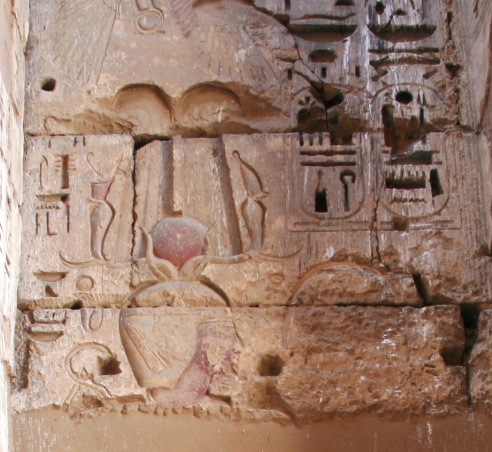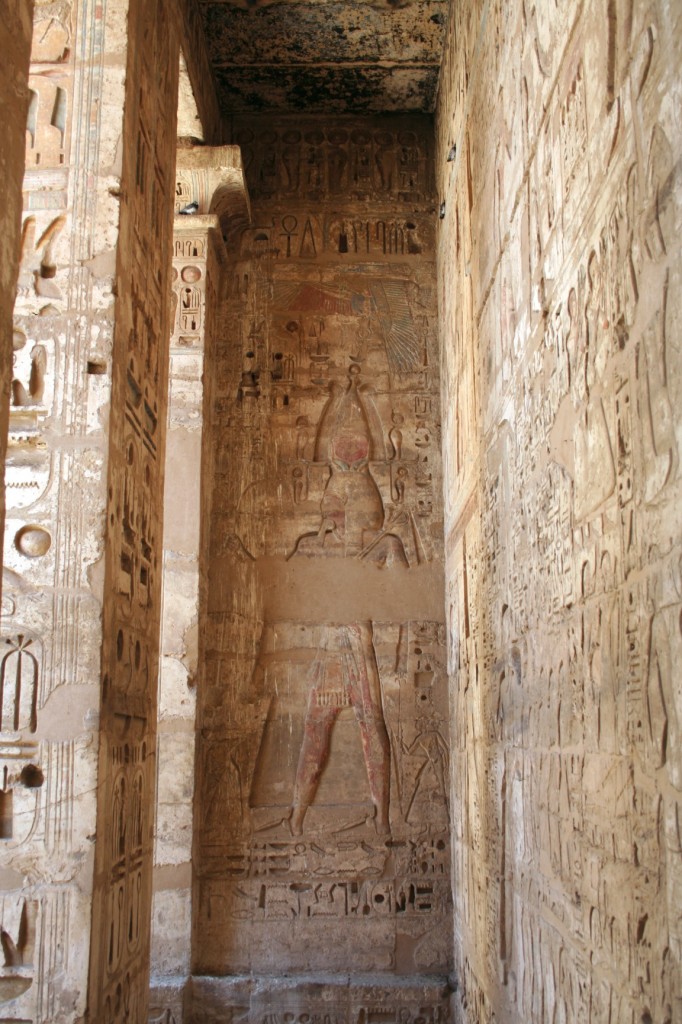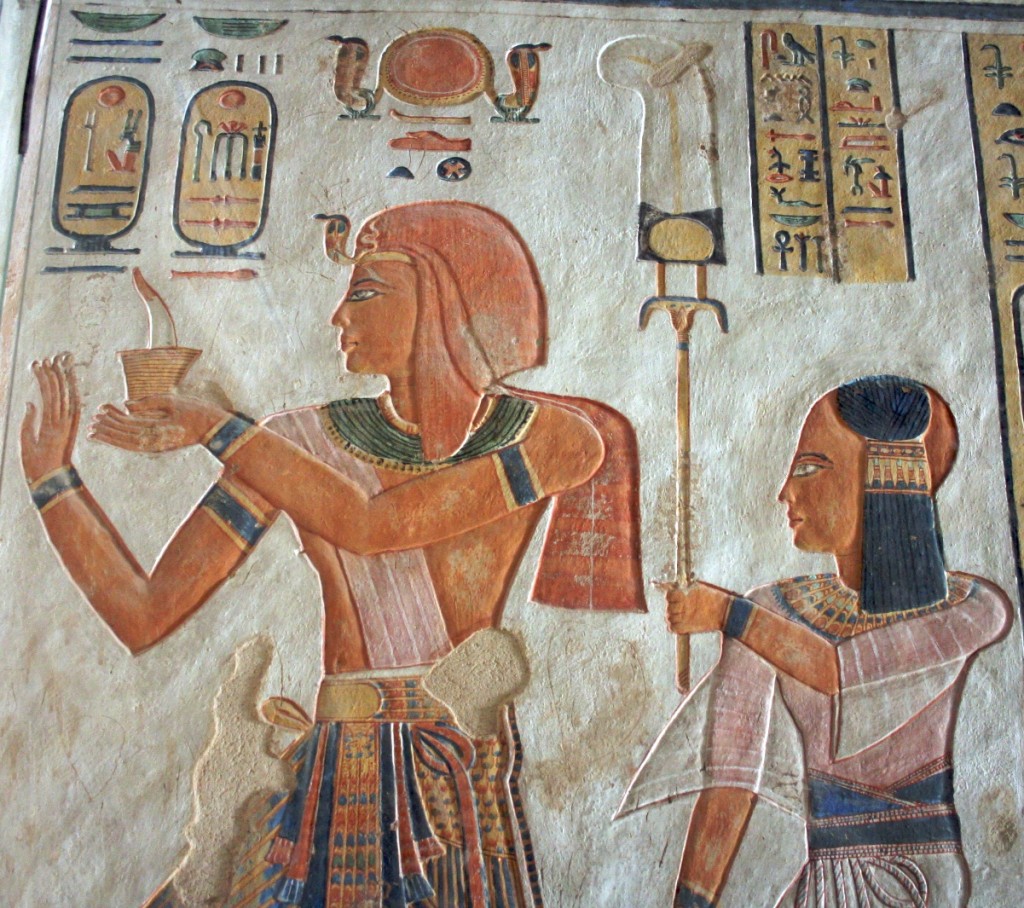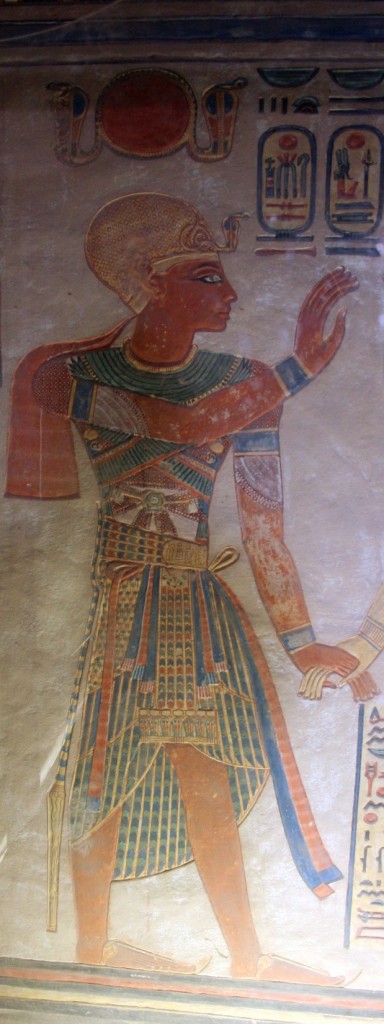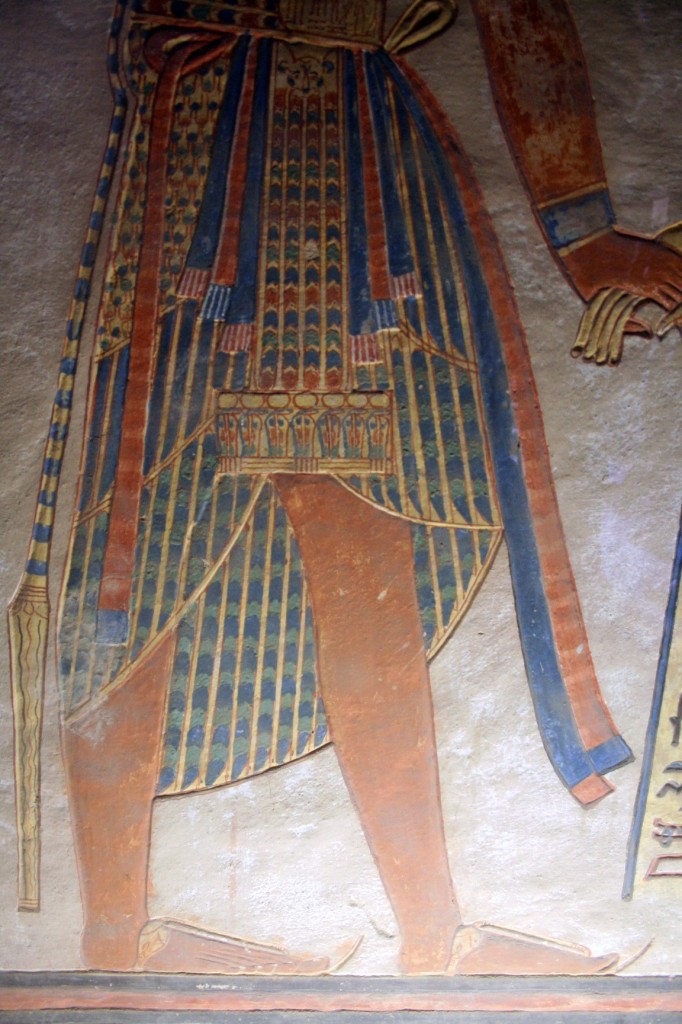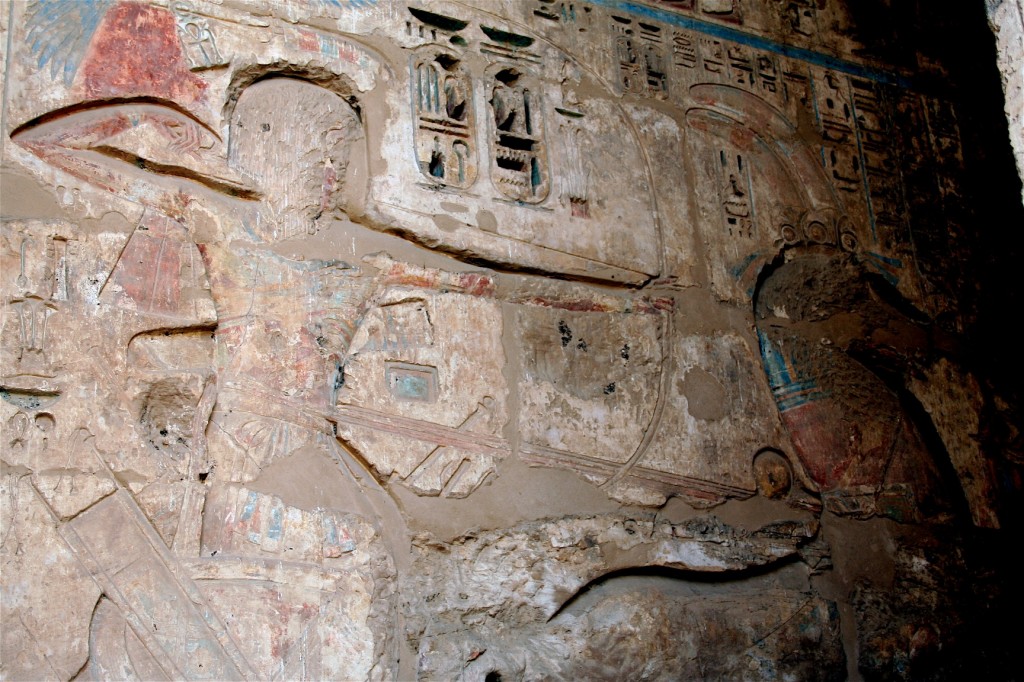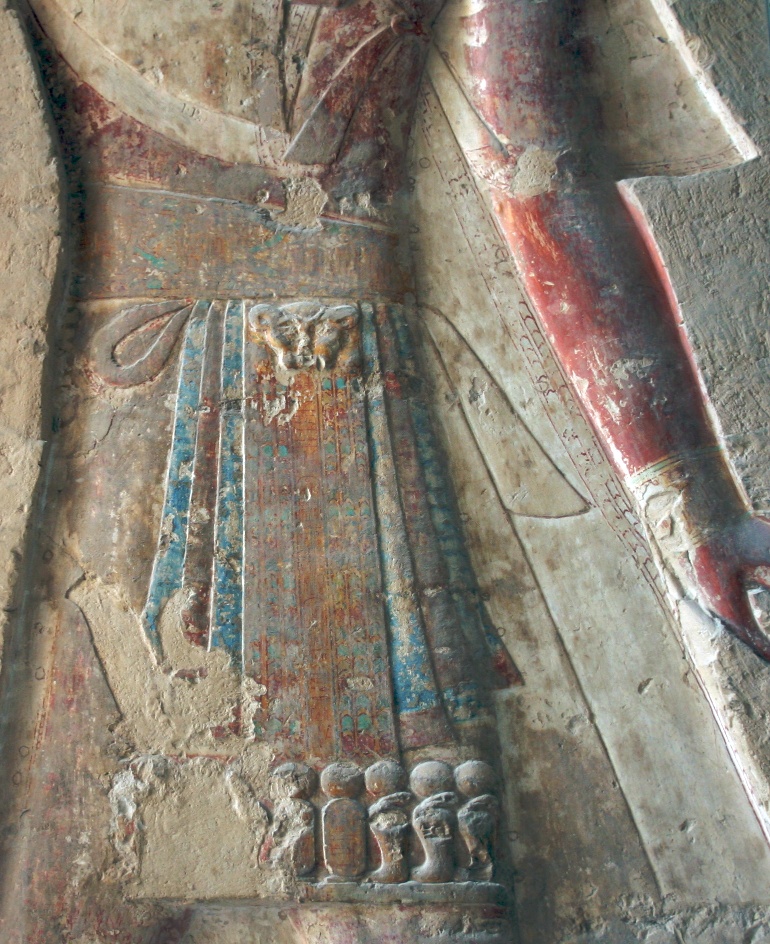What meaning did the red looped sash worn at the king’s waist hold for those who saw his image? What message was it intended to convey? In this final post (the last in a four-part series) on the looped red sash, all of the threads from the three previous installments of this examination will be brought together to form a quantifiably-supported thesis about the significance of this regalia element.
There are three previous sections of this discussion, and this conclusion assumes the reader is familiar with them. The first examined the meaning of sashes in general and touched on previous scholarship on the looped sash, the second highlighted the significance of the color red in ancient Egypt, and the third delved into the appearances of this regalia element among the images of the pharaoh at the memorial temple of Ramses III at Medinet Habu.
At the end of the third installment, we showed that the general patterns of usage for the looped sash are clear from the data from Medinet Habu. From the examples at this temple (and supported elsewhere), it can easily be seen from the analyses that the looped sash was used often in slaughter and smiting scenes, scenes that show the king being led or receiving insignia of kingship, and certain offering scenes (usually where the king presents incense, bouquets, or Ma’at). However, it is somewhat difficult looking at the 72 examples from Medinet Habu to determine the precise meaning conveyed by the looped sash that makes it appropriate for these disparate types of scenes. By closely examining a specific small selection of scenes, namely the four large-scale images of the processing king appearing in the corners of the first courtyard, we will offer a clearer view of the particular meaning conveyed by this element of royal regalia.
Uncovering the significance of the red looped sash as royal regalia
The highly unusual nature of the attribute combinations making up the king’s costumes in the four corner scenes found in the first courtyard at Medinet Habu is statistically indicated. These constructed images of idealized kingship are potentially illuminating in terms of gaining an understanding of the red looped sash.
Southwest corner (MH plate 123A) (Many thanks to Alain Guilleux for this image!):
Southeast corner (MH 123B):
Northeast corner (MH 124A):
Northwest corner (MH 124B):
There are three levels of connection between the corner scenes:
- On one level—headgear—they are almost completely disparate
- At the second level are the multiple pairings that appear to define the sides of the courtyard
- On the third level, the corners are obviously connected by the many elements that they share
The scenes share numerous attributes, not only items of costume, but contextual elements as well, such as the sunshades that appear in all four. The scenes are also paired, along both N-S and E-W axes, by certain regalia and other elements. Due to the complexity of the relationships, these pairings and connections may be most fruitfully discussed in conjunction with a series of diagrams (the diagrams in this post are from my soon-to-be-defended PhD dissertation).
Diagrams outlining the paired elements defining the sides of the courtyard:


The south side of the courtyard (MH 123 A & B), where the king wears the khepresh crown and lappet wig, is most obviously differentiated by the ankh that pharaoh holds in his hand. Ramses also sports a crown streamer only in these two depictions, but this attribute almost never appears on the nemes or round wig at Medinet Habu, so its exclusion in the other two scenes is likely not directly significant. In both of these vignettes, unlike the northern images where there is only one, the king is shielded by two sunshades. This variation may be a reflection of the difference in the size of the northern portico, which is slightly narrower than the southern one.
Detail of MH 123A:
Detail of MH 123B:
On the north side of the courtyard (MH 124 A & B), there are several elements that distinguish this pair of corner scenes. One of these is the royal beard. However, like the streamer, the beard tends to have exclusive and consistent relationships with particular crowns, never appearing with some and always appearing with others (I am currently unaware of any examples of either the khepresh or the lappet wig being worn with a beard), so its exclusion from the southern images is secondary. The sash skirt that is worn only in the northern depictions, on the other hand, is of interest. There are numerous examples at Medinet Habu of this attribute being worn with the khepresh crown (109 times) and the lappet wig (45 times), but the two southern images clearly do not wear the skirt under their transparent garment as the northern pair does (difficult to discern on MH 124B, but recorded by the Epigraphic Survey). The northern pair is also differentiated by the crook and flail, which both images hold up to rest on their shoulder.
Detail of MH 124A:
Detail of costume in MH 124A:
Detail of MH 124B:
Detail of costume in MH 124B:
The eastern pair (MH 123B and 124A) is distinguished by the fact that both depictions show pharaoh wearing a flanking apron. These images of the processing pharaoh appear shielded with only sunshades.
Detail of apron in MH 123B:
Detail of apron in MH 124A:
On the west side of the courtyard, MH 123A and 124B depict the king being shaded by both sunshades and khu-fans. This pair also sports prominent multiple aprons of similar configuration. The bases of these complex items of regalia both show six solar-disc topped uraei flanking two cartouches, but note that those in 123A face out while the cobras in 124B face forward..
Detail of the apron in MH 123A:
Detail of apron in MH 124B:
While the completely different headgear that the king wears in each corner distinguishes the depictions from one another, there are also a number of variables that appear in all. All four of these images of divine kingship portray pharaoh wearing a shebiu collar, broad collar (almost certainly in all but very difficult to discern in MH 123B), transparent garment, looped sash, and sandals. The scenes all show the king being shielded by sunshades, and a vulture hovers above in all four as well.
Diagram summarizing pairings and elements shared between the four corners:
The anomalous behavior of some of these regalia appearing together, particularly the crowns, is clearly indicated by the statistical analyses. For instance, it is only in these four corner scenes that the king wears an atef in conjunction with a flabellum or a transparent garment. Similarly, the shwty crown only appears with the crook and flail once in the current database—in MH 124A. Although both the khepresh crown and lappet wig were commonly worn with the looped red sash, it was rarely combined with the other headgear. There are only 3 examples at Medinet Habu where Ramses wears a nemes topped with an atef crown in combination with the looped sash (MH 124B, MH 235–a large scene where the king is led to the Theban Triad to receive insignia of kingship, and a smiting scene on the column to the west side of the main Window of Appearance opening). The round wig topped with shwty feathers is only combined with the sash 6 times–in five smiting scenes and in MH 124A. The was staff that the king holds in all four depictions is also unusual. This attribute appears in the king’s hand in only one other scene in the outer parts of the temple, within the portal of the Window of Appearance (MH 238A). The statistical analyses reveal the rarity of the regalia combinations and support the interpretation that these images of pharaoh are intentionally constructed for this context. When attributes that typically repel each other were collected in the costume of the king, it is doubtful that it was accidental.
In these four scenes, the red looped sash was considered appropriate in combination with all of the headgear in this particular context. It seems likely then that there is an underlying connection between the crowns selected for these scenes, beyond the fact that they represent various aspects of kingship. All four of the headgear types relay something specific about a role the king was expected to play in the maintenance of the cosmos.
Diagram summarizing the significance of the headgear worn in the four corners:
The khepresh crown in the southwest corner relates to the king as Amun and identifies pharaoh as the divine representative of that deity on earth (S. Collier, The Crowns of Pharaoh, UCLA PhD dissertation, 1996, p. 145). The lappet wig worn by Ramses in the southeast corner, which is connected with the military, may be indicative of the prowess and virility of the living king. Its use here might be intended as a statement about his success at protecting the borders of Egypt. In the northeast corner, the pharaoh wears a round wig, seshed-diadem and shwty crown. This combination links him with Horus as the son of Isis (Collier, 58). There is a connotation of celestial brilliance in the regalia, and the solar nature of the costume is emphasized by the inclusion of a panther at the top of the king’s apron. The seshed also identifies him as the son of Hathor, the one who was “perfect” at appeasing the angry solar Eye. In the northwest corner, Ramses appropriately wears a crown that connects him not only with the deceased king as Osiris, but also the god Re-Horakhty at the moment of dawn (Goebs, Crowns, 111). The nemes and atef crowns legitimize the king as the deputy of Re while also permitting the deceased king passage in the duat as Horus when he descends to rejuvenate Osiris.
The texts in both of the eastern scenes (MH 123B and 124A) appropriately refer to the king as appearing “like Re.” In the southwest corner (MH 123A), Ramses is likened to Atum, the completed one that was connected with (among other things) the setting sun. The image of the king, however, shows him in the crown most closely related to coronation and thus the initiation of his rule. Additionally, the text behind the king states that he is coming to appear (or perhaps to be crowned) as the njswt bjt upon the throne of Horus. The combination of these two aspects, the image and text, could be seen as representing the entirety of the rulership cycle, where he is simultaneously being renewed through the rites of coronation and representing the ‘completed one’ who descends into the western horizon.
As mentioned above, the four corner scenes at Medinet Habu are the only depictions in the current dataset where the looped sash appears in conjunction with the was staff. This staff is a hieroglyph for the word ‘dominion’ and is also connected to the city of Thebes. In addition, the was came to be used as a representation of the pillars that support the sky. As such, the staff could be viewed as indicating the dominion of the king over not only the terrestrial realm, but over all of the cosmos. In these scenes, the was might be carried by the king to identify him as the ruler of Egypt on multiple levels. Appearing in the four corners, the was staffs symbolically encompass all of creation and bring it under the control of Ramses III.
In the two southern scenes (MH 123 A & B), the king carries an ankh in addition to the was, but in the north corners (MH 124 A & B) the king grasps the crook and flail instead. This contrast may be related to the two southern depictions perhaps being seen as images of the living king. The khepresh crown has been suggested to identify the king as a representative of Amun on earth, and the lappet wig, with its military connections, might also visually indicate the ruler as a living human. In contrast, the depictions of the king on the north side of the courtyard, clearly identified by their headgear as Horus and Osiris, likely represent not a living human but the embodiment of the eternal cycle of kingship.
There is one thing that connects all of these royal roles and the four depictions of the king in the corners of the first courtyard at Medinet Habu. The king appears as the sun god at dawn, as Osiris with his unending potentiality and creative force, as the young Horus, and as the military leader, the human who guards Egypt’s borders like Seth protects the prow of the sun bark. In each of these scenes, the deity the king is being identified with is almost always guarded by at least one goddess.
The data therefore suggests that the red looped sash worn at the king’s waist is a ritual knot providing a visual reference to the active protection of a goddess. Which goddess would probably depend on the king’s context and the deity he with which was being associated.
The strong connection of the red looped sash with the solar cycle has been noted in previous sections of this discussion. Due to this relationship, it may be argued that the goddesses related to the Eye would have the closest connection to the looped sash. Their aggressive nature, which could represent “royal power at its most brutal,” would make them most appropriate guardians on the battlefield (G. Pinch, Mythology, 130). They are also powerful enough to restrain chaos in the emblematic smiting scenes, similar to the way they tie back Apophis so the solar bark can continue unhindered. Like the sash, the Eyes had a dualistic nature and were both destructive (Eyes of Re) and creative (Eyes of Atum). The Eye was sometimes viewed as a symbolic womb, the place where the gods were formed. In wrapping around the body of the king, the looped sash ‘engulfs’ him similar to the child gods who are sometimes depicted in the womb-like pupil of the Eye. The stylized similarity between the form of the sash and an umbilical cord may be related to this concept. Many goddesses could be represented as Eyes, including Hathor, Mut, Isis, and Sakhmet, and these aspects were considered “divine power at its most interventional” (Pinch, 128) These beings had exceedingly aggressive faces and benign nurturing sides, both of which were of great importance in the maintenance of the cosmos.
The looped sash, with its aggressive connotations, serves the dual function of providing a visual reminder of the king’s appropriate actions as Egypt’s guardian while also signifying the nurturing embrace of a goddess. In the four corner scenes, the disparate headgear makes it clear that the images of divine kingship are intended to represent the pharaoh as four different divine embodiments. Each of these may be symbolically guarded by a different Eye goddess, particularly appropriate for the deity with which the king is identified.
In the southwest corner (MH 123A), pharaoh is identified as the manifestation of Amun. The khepresh crown is also associated with coronation, which involves the king making a transition from one state to another. The crown is connected to rebirth and rejuvenation and identifies pharaoh as the living ruler (B. Bryan, “A ‘New’ Statue of Amenhotep III and the Meaning of the Khepresh Crown,” in Z. Hawass and J. Richards (eds.), The Archaeology and Art of Ancient Egypt: Essays in Honor of David O’Connor, 157) . Mut, the wife of Amun, queen of the gods, and mother of each king, would be a very appropriate guardian in this context. She is largely benevolent and it is through her milk that pharaoh gains the right to rule, but as an Eye goddess, Mut also had a fierce aspect. She additionally possessed a divine weapon, known as the ‘flame of Mut,’ whose power was not restricted to the divine realm but could be utilized in the terrestrial plane as well.
Southwest corner (MH 123A):
Wearing the lappet wig in the southeast corner (MH 123B), Ramses is depicted as the living ruler. Considering the ‘democratic’ nature of this type of headgear, the use of this wig by pharaoh may be intended specifically to emphasize his humanity. Its military connections and practical use on the battlefield tie in with pharaoh’s role as the guardian of Egypt, protecting her borders and keeping chaos in check. The aggressive nature of this depiction indicated by the headgear, makes Sakhmet an extremely likely candidate as the goddess suggested by the looped sash. This goddess, “She who dances on blood,” embodied all the harnessed negative powers of solar heat (Pinch, Mythology, 188). Sakhmet stood on the prow of the solar bark and ably defended the sun god from the monstrous Apophis. She was particularly dangerous in times of transition (such as the New Year) and had to be placated in order to avert disaster. Her aggressive heat was often described as being projected on behalf of the king in battle, and a similar intense protection may have been deemed necessary here.
Southeast corner (MH 123B):
The northeast corner (MH 124A), shows the king wearing the round wig and seshed diadem topped with shwty feathers. These regalia elements identify him with several different aspects of Horus, as well as Nefertum, the one who was “perfect” at appeasing the Eye. The goddess Hathor, who embodied the female creative principal, would be a very appropriate goddess to shield the king in this context. Like Sakhmet, Hathor is described as standing on the prow of the sun bark—both represent particularly aggressive aspects of the Eye proper for the east side of the courtyard. Hathor was the mother of Nefertum and of Horus, both of whom the king is directly connected with through his headgear in this corner. Similar to Mut and Isis, rights to rulership flowed with Hathor’s milk and her acceptance of the king legitimized his position.
Northeast corner (MH 124A):
Isis is the most likely goddess suggested by the looped sash worn by the king in the northwest corner (MH 124B). Pharaoh is identified by his headgear with both Osiris (the inert one whose creative potential is unbounded) and Re-Horakhty (who represents the sun at the zenith of his power). The combination of the nemes and atef crowns has also been linked with Herishef, the fused Osiris and Re who was considered the embodiment of kingship. This powerful merged being succinctly sums up the entirety of both solar and the kingship cycles within a single image. Ramses is identified with both Osiris and Re-Horakhty, and this potent merged image would perhaps be best guarded by the powerful Isis, who, as Weret-hekau, had the capacity to bind together inertness and transform it into living matter. Ramses in this depiction effortlessly transitions from one phase of the cycle to the next, being one moment the deceased, idealized ruler beginning his decent into the west and the next, having symbolically united with Osiris in the depths of the Netherworld, emerges at dawn as the rejuvenated solar god. Isis’s role in this process, in gathering and joining the disparate parts of the dead Osiris-king and through her magic revivifying his flesh in order to transform inertness into life, was essential.
Northwest corner (MH 124B):
Different guardians being represented by the looped sash is supported in contexts outside of the four corner scenes as well. For instance, in the well-preserved tombs of his sons, Ramses III prominently wears the looped red sash in all of his depictions (where it can be determined).
Ramses wearing a looped sash and feathered back apron in QV 44:
Ramses wearing a falcon wrapped around his cap crown in QV 44:
These images also show him clad in a great deal of falcon imagery: several times the king has a falcon wrapped around the back of his head, a feathered back apron occurs on multiple occasions, and the pharaoh sports full feathered garments at least once each in QV 44 and 55. The plethora of falcon iconography shows Ramses as the living king and relates him to the young Horus; the red looped sash in these depictions could thus be a reference to the protection of Isis.
Ramses wearing feathered garments and being embraced by Isis in QV 55:
Detail of the king:
Detail of feathered kilt:
When the king is shown in battle or smiting while wearing the looped red sash, the goddess suggested by the red linen is likely Sakhmet or Hathor, representing the aggressive aspects of the solar Eye. The Year 8 inscription at Medinet Habu, for instance, records that the king appears “like Sakhmet storming at the time of her fury.” The previously mentioned references to these deities as being clad in bright red linen lends further support to such a theory.
Ramses engaged in slaughter wearing the looped sash:
Rituals from the temple of Seti I at Abydos additionally suggest a connection between the red cloth and the Eye. In the chapel of Re-Horakhty, the king presents red cloth to the god as he asks for the Eye of Re to appear (R. David, Religious Ritual at Abydos, episode 21, 68).
The protection of female deities, which seems to be implied by the appearance of the looped red sash at the king’s waist, is explicitly stated in some texts. The king is often depicted in relief and statuary as the passive recipient of a deity’s embrace, a state that may be analogous to the use of merj, indicating the active love and protection of the deity, in texts (W.K. Simpson, “Amor Dei” in J.Assmann et.al., eds., Fragen an die altägyptische Literatur). Perhaps most related to the sash are references to the ‘reaching out’ or ‘wrapping of arms’ around the king by a goddess that appear in text and relief. For instance, in MH 44, Mut specifically says “I put my arms as a protection around you while my heat is against your enemies.” This supports the concept of both an apotropaic and aggressive aspect to the symbolic shield provided by the goddess, much like the Western desert who says to the dead “with my arms having encircled (paher) you forever and ever, truly I will be the sa (protection) of your flesh.”
East face of south tower of the second pylon (MH 44):
Although indicative of ‘encircling protection’, paher is also used in reference to capturing and controlling potent foes (Ritner, Mechanics, 65). Ritual knots (which the looped sash would be considered) not only carry with them the connotation of creation, but they also stand as the “tangible counterpart to… paher”(Ritner, 144). This concept also supports the idea that the regalia served a dual function. Although its primary aim may have been to surround the king with an apotropaic shield, the protection of the individual pharaoh might not have been the most important aspect. By imparting great strength and divine protection to the king, he was in turn able to conceptually project that divinely-wrought shield around all of Egypt. In the texts at Medinet Habu, for example, the king is explicitly called “great wall that shelters Egypt” and “heroic protector,” highlighting his obligation as pharaoh and his role as the one who maintains cosmic function.
It could be in its function of projected protection that the red looped sash may additionally imply a vital and aggressively male force. As mentioned in an earlier section of this discussion, the color red is closely linked with the god Seth, and the deity even appeared sometimes with red eyes and hair. Although Seth was the embodiment of chaos (or perhaps because of it), he also was the guardian of the sun god and was responsible for slaying the monster Apophis. As Seth is the primary enemy of Osiris and of Horus, the concept of a Sethian ‘protection’ around the king himself may be problematic. However, several pharaohs (such as Seti) took pains to identify themselves with this deity and his virility, and a direct association between the raging king in battle and Seth was made long before the time of Ramses III. Many references to the king as a manifestation of the god of chaos appear in the texts at Medinet Habu, such as, “I cause you to be seen like Seth, slaying at the prow of the sun bark.” It is not the king that is the recipient of the wild power of Seth, but Egypt herself who benefits from the divinely-imparted chaotic powers pharaoh displays on the battlefield.
The looped sash worn at the king’s waist may carry an implication of the merging of male and female creative aspects within the body of the king, especially considering the concept of knots containing the hidden force of germination (mentioned in the first section of this discussion). Lana Troy has highlighted some of the Egyptian ideas regarding androgyny, particularly as it related to creative potential (L. Troy, Patterns of Queenship, 15-19). She notes that the solar disc with pendant uraei displays an inversion of the usual gender modes and that it is this inversion “which characterizes the identity given the solar disc as creator” (Troy, 20). The ‘male’ disc, aten, is a uterine symbol, while the uraei, although securely feminine in identity, are viewed as ‘phallic’ here.
The looped sash as an element of royal regalia may be seen similarly, with the loop as uterine and the trailing sash as phallic. This symbolism might suggest that the loop was the more ‘required’ of the two since pharaoh himself could be considered ‘phallic’ already. In some instances, such as in the scene found at the top of the outer corridor in the tomb of Ramses III, the red sash appears only as the loop and does not include the long tail.
Detail of the king’s costume in the Litany scene in the tomb of Ramses III (KV 11):
The fact that there are several variations for how the looped sash was depicted may also be related to this concept. Additionally, as an object the long red sash could carry connotations of androgeny (and thus creative potential) due simply to the fact that the same fundamental item has the capability to be both the king’s regalia and goddess’ attribute—it all depends on how it is tied.
The aggressively apotropaic embrace of an Eye goddess indicated by the red looped sash would be very appropriate for the Litany of Re scenes found in the tombs of Ramesside kings, many of which were illustrated in the first post on this topic. The Litany focuses on the union of Re and Osiris in the Netherworld, an action that resulted in the rejuvenation of both gods (E. Horning, The Ancient Egyptian Books of the Afterlife, 138-9). Beginning with Seti I, this text appeared in the first corridor of the royal tomb and was initiated by a vignette showing the king before Re-Horakhty and sometimes other deities. These depictions show the king at the point of descending into the western horizon, a liminal zone of great potential danger. Of the twelve preserved examples in royal Ramesside tombs, the looped sash definitely appears in eight of them.
The data gathered about the looped red sash has shown that:
- 1) in form and material, it is a ritual knot connected to divinity and potent symbols of protection and revivification (the ankh and tyet)
- 2) in coloration, it is related to the solar cycle, especially the dangerous regions of the liminal zones at the eastern and western horizons, and to the powerful Eye goddesses who guarded the sun god on his journey
- 3) the contexts in which the red looped sash appears on the king are those where he is in a potentially hazardous venue (slaughter scenes), is actively controlling chaotic elements (smiting scenes), is depicted in triumph over chaos (being offered battle spoil), is in a conceptual or physical liminal zone (being led or receiving insignia, flanking the entrance to the temple proper, and the Litany vignettes in the royal tombs), or is presenting certain types of offerings (mostly Ma’at, bouquets, ointment, and incense).
Through a combination of exacting recording of scene elements in an easily searchable format and complex statistical analysis, the Art of Counting project has provided a quantifiably supported thesis about the significance of the red looped sash worn by the king. From these data, the consistent usage patterns for this regalia element, and using the varied analyses carried out on the scenes at Medinet Habu, the Art of Counting believes it can state that the red looped sash was a ritual knot, intended to provide protection for the king as a visual reference to the active embrace of an apotropaic goddess. As the database expands, all indications–from the survey of numerous other monuments of the period mentioned previously–are that these patterns will remain consistent, reinforcing this conclusion.


